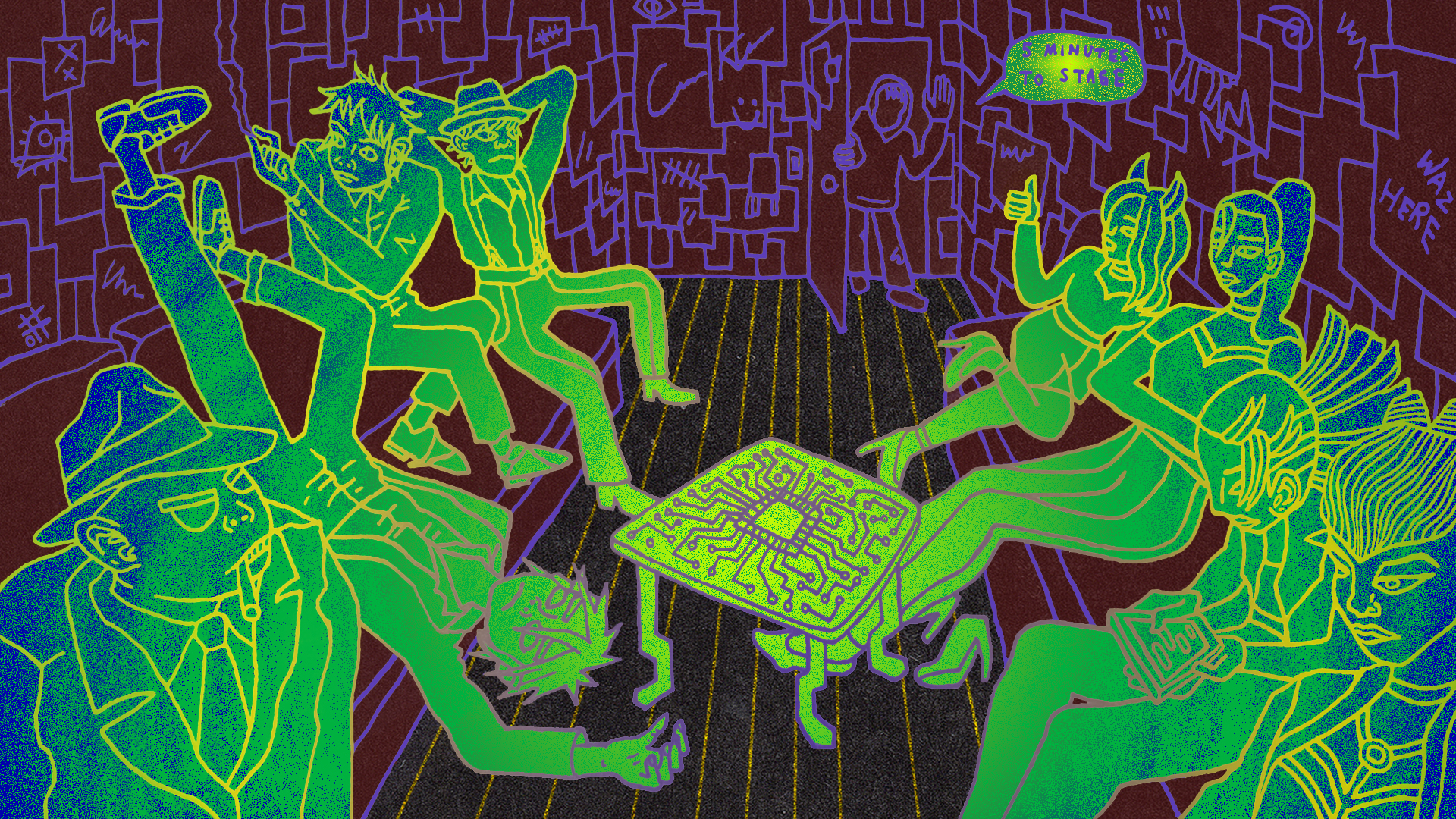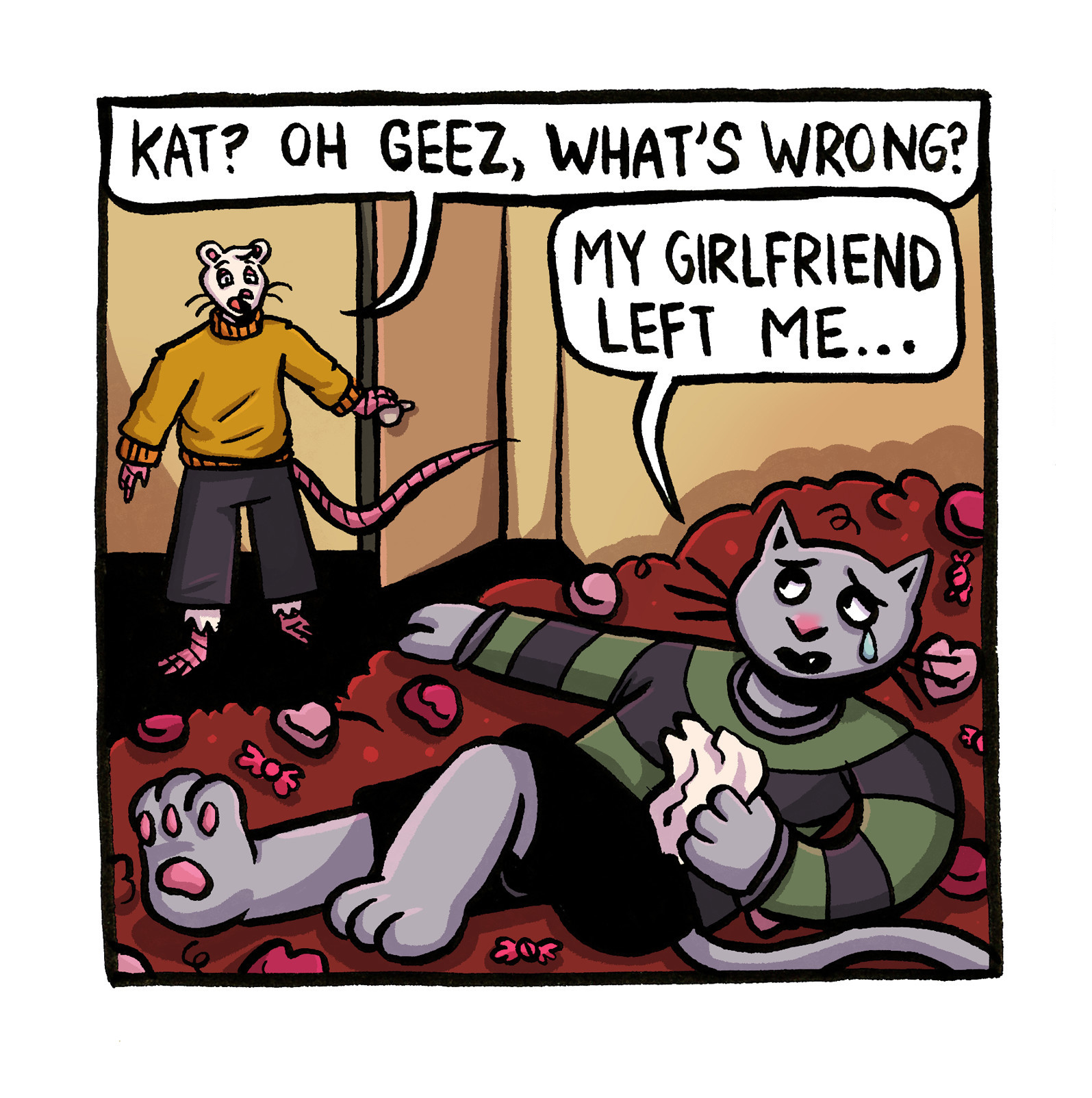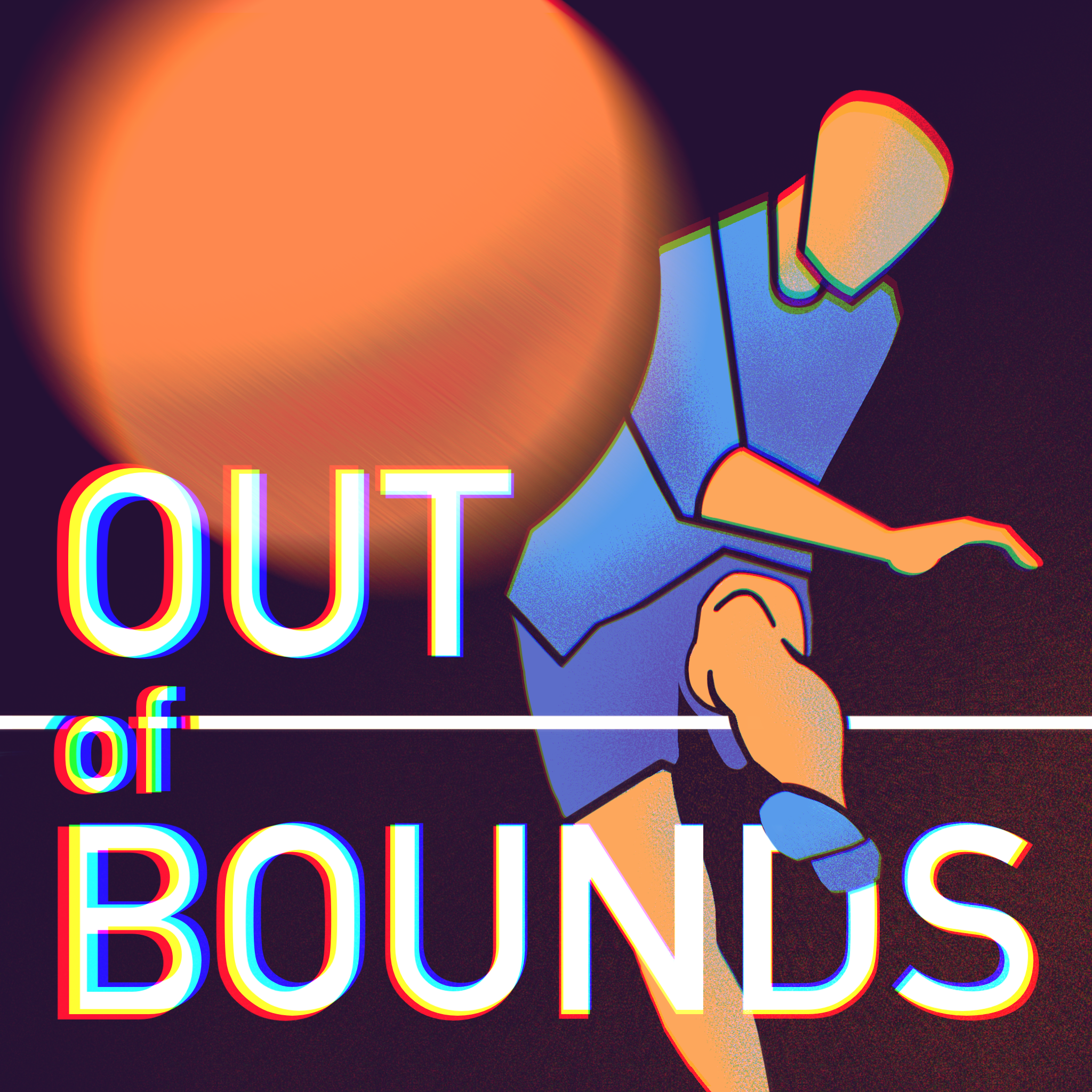
An effervescent, luminous cityscape. A sleek black motorcycle, its contours defined by ambient red light coming from futuristic patterns projected on the wall monitors surrounding it. Four women in leather Korean-inspired streetwear, lounging in a throne room made of gold, marble, and … are those diamonds?!
These are the first few scenes you’ll see in the music video for “MORE,” one of the most anticipated tracks in pop music, which premiered on Oct. 28, 2020. Set to a riotous combination of crisp hip-hop beats, barnstorming K-rap, and dulcet melodic hooks, you might be forgiven for thinking that this was just another lush, no-holds-barred, single-slash-video release featuring some ubiquitous top-of-the-pop-charts collaboration. You would even be partly correct — except none of the women you’re seeing onscreen are, well … real.
Meet K/DA — a virtual, bilingual pop band comprised of four characters from the smash-hit video game “League of Legends.” Sonically, they’re what you’d get if you mashed Blackpink and Ariana Grande together in a pop music supercollider. Aesthetically, they’ve come straight out of a futuristic cyberpunk anime world so polished it makes “Into the Spider-Verse” look like a PlayStation 2 game. K/DA’s four members, each with their own distinct mononym — Ahri, Akali, Evelynn, and Kai’sa — are completely fictional video game personas, brought to life by a rotating cast of established pop musicians, including the likes of Kim Petras, Madison Beer, and members from K-pop outfits (G)-IDLE and TWICE.
Yes, you read that right. Music is entering a new, virtually-powered realm, in which the already sleek and shiny, social-media-perfect images of established pop personalities take a backseat in favor of 3D models of anime girls. Now that’s something I’d like to see covered on the History Channel in 20 years.
Given the almost incomprehensible levels of star power involved in a single musical project, it should come as no surprise that K/DA has taken the world by storm since their debut track “POP/STARS” premiered in 2018. “POP/STARS” topped the Billboard charts upon release, and its music video has been viewed on YouTube 418 million times — the most successful music video for a virtual act, second only to Gorillaz’s “Feel Good Inc.,” which was re-published on YouTube four years ago and currently stands at 470 million views. This meteoric rise hasn’t quite petered out yet, either — their 2020 EP “ALL OUT” was released on Nov. 6, and garnered tens of millions of Spotify streams in the first three days after its release.
With the COVID-19 pandemic still raging across the world, and the resulting multi-layered importance that the word “virtual” has taken on, it would be easy to mistake K/DA for a project launched to give its members more creative freedom; to produce pop music under a fictional united front without having to worry about the constraints of language, genre, or touring. However, you won’t find those previously-mentioned real-life pop idols at the forefront of the band’s image. K/DA’s concerts are almost entirely conducted via augmented reality, teetering on the edge of the uncanny valley (and occasionally falling in altogether). Several artists who have voiced these characters even act as though they’re keeping their starring roles in K/DA an ill-kept open secret — for instance, you’d be hard-pressed to find any mention of the virtual girl group on Madison Beer’s social media platforms, despite having voiced Evelynn on three of the band’s six tracks.
All this just begs the question … What is the point of K/DA?
We need look no further than the single thread running through the heart of the band — Riot Games. The gigantic, game-studio-turned-record-label have their stamp on every inch of what makes K/DA a standout project, and what keeps the fans coming back for more. The vocalists responsible for breathing life into the band are hand-picked by Riot. The characters they play are, in turn, wholly designed and owned by Riot. The ever-rotating nature of Riot’s chosen musical cast, coupled with the foregrounding of digital personas over their real-world counterparts, implies that each of the cogs in the neon-drenched K/DA machine are easily replaceable, commodities for Riot to use and discard without having to worry about the accountability that non-virtual bands usually face when replacing their line-up. Even the name of the band itself comes from the League abbreviation for “kills, deaths, assists” (aka: the ratio by which a player’s performance is measured); a concept that does not exist outside of defined Riot gaming parameters. K/DA is a project so intricately bound to Riot Games and “League of Legends” that any attempt to remove the band from the clutches of its corporate gamemaster overlords would result in the total collapse of a simulation so hyperreal it would give Jean Baudrillard an aneurysm.
Would it be too harsh to say, then, that K/DA are nothing more than perfect artifice; with a money-hungry game studio with a worryingly lengthy track record of sexism at its core? NBC News certainly thought not; calling K/DA “not so much a band as a digital marketing campaign” in a 2018 article. That damning accusation aimed straight at the hollow core of K/DA certainly holds some weight, too, when we consider that this virtual band has no real “voice,” no distinct personality that can be expressed in interviews and press tours. When compared to other pop songstresses such as Ariana Grande, Lana Del Rey, and Billie Eilish, whose own carefully-crafted cults of personality have drawn in hordes of adoring fans who see themselves mirrored in these personas, that is where NBC News’s scathing remark really rings true. Take away the cute anime girls, and we are left with nothing to hang on to beyond the music.
Is the rise of the virtual band the real Death of the Author, then? Not the separation of art from the artist, as Roland Barthes imagined, but the creation of art in a vacuum?
Are we facing the erosion of pop stardom, the cult of personality, as we know it?
To answer this question, perhaps we should turn, as a point of comparison, to the band that started it all.
Gorillaz are a virtual band — no, the virtual band, that needs no real introduction. They were even mentioned earlier in this article because no one can talk about virtual bands without talking about Gorillaz. In both sound and appearance, they serve as a more synthetically and aesthetically reserved counterpoint to the pomp and circumstance of K/DA’s no-holds-barred, K-pop bombast, and yet they, too, command veritable legions of fans that hang on their every move, hungry for as many new releases as they can get.
Rather than being re-skinned co-options from a video game franchise that was already internationally famous, the motley crew of characters that make up Gorillaz were born out of more organic means — dreamt up by Albarn and Hewlett when they shared a flat in West London. Conceived and drawn to life in 1998, Stuart “2-D” Potts, Noodle, Murdoc Niccals, and Russel Hobbs — the fictional foursome that make up Gorillaz — were unlike anything that pop culture had ever seen before.
In the time of N-SYNC, Westlife, and the Backstreet Boys, the idea that music could be produced and helmed by characters who weren’t real people was something that had never been tabled before. When Gorillaz finally released their self-titled debut album in 2001, accompanied by four animated music videos and plenty more animatics on the life and times of the band, it was met with thunderous fan reactions and critical acclaim, going triple platinum in the U.K. and double platinum across Europe.
While the breath of fresh air that Gorillaz brought to pop and hip hop certainly helped the band’s success, it would be misleading to claim that that quirky, never-before-seen originality is what initially drew most Gorillaz fans to them. Let’s not forget that Damon Albarn was also the frontman of Blur, one of the biggest bands in 90s Britain, and Jamie Hewlett was one of the co-creators of “Tank Girl,” a comic that would go on to define the aesthetic of British punk counterculture for decades to come. To claim that Gorillaz had nothing going for them except the novelty of being a virtual band in a time when dial-up Internet access was mind-blowing new technology, would be like saying that Albarn and Hewlett had created a thriving business with nothing but a dream and ten million dollars in their pockets.
Gorillaz certainly owes some of its popularity to Albarn and Hewlett’s already-established reputations, but the hefty legacies that their creators carry are just the tip of the iceberg. While most Gorillaz “interviews” constitute talks with Albarn and Hewlett on their creative processes, the fictional Gorillaz members themselves are also depicted as free-standing personalities distinct from their creators. 2-D, Noodle, Murdoc, and Russel have done numerous interviews (as two-dimensional characters in an otherwise three-dimensional world), appeared on a particularly surreal episode of MTV Cribs, and have even “clashed” with Albarn in the real world. Fans of the band who choose to invest in more than just the band’s music often find themselves captivated by the four fictional characters at the helm of the band and their animated madcap exploits, which add an extra layer of zaniness to their genre-hopping sound.
Unlike K/DA, whose members remain free-standing figures with no recorded past nor projected future, their very essence based around their affiliation with “League of Legends,” the four members of Gorillaz have been continuously injected with rich, evolving backstories ever since bursting onto the music scene in the early 2000s. More serious fans of the band could easily find themselves drowning in the sheer amount of apocryphal material surrounding the band members’ lives, which include a 2006 “autobiography,” the elaborate narrative arcs in the band’s music videos and concept albums, and early animatics and bite-sized cartoon episodes that served to establish each member’s storied past and numerous defining quirks.
To name just a few of those quirks — drummer Russel is a mountainous, 340 lb. man who enjoys taxidermy, bassist Murdoc is a green-skinned quasi-zombie jailbird Satanist, guitarist Noodle is a genetically-engineered Japanese super-soldier who was smuggled into the United Kingdom in a FedEx crate, and frontman 2-D gets his nickname from the two dents in his head, a result of Murdoc running him over with a car. The rich history behind Gorillaz is a rabbit warren of a story in itself, a la “Homestuck” or similar, long-running alternative narrative forms, which perhaps harks back to Hewlett’s origins as a comic book creator.
And yet, even though Gorillaz fills the void of personality that K/DA chooses to leave untouched, the Gorillaz experience is arguably still devoid of a central cult of personality. The connection that one makes with the characters on display is more cerebral than emotional — like being engrossed in an excellent craft of fiction rather than being seduced by a persona’s appeal or relatability.
And what of the band’s connection with the artists who give it life, I hear you ask? Well, take any recent Gorillaz album and you’ll find that it’s populated by a veritable circus of sometimes more than 20 artists and musicians. However, unlike K/DA’s treatment of its defining artists as “cast and crew,” the only Gorillaz-affiliated musician who receives this excising treatment is Albarn himself. All other artists who appear on Gorillaz tracks are listed as featured artists; individuals who exist outside Gorillaz’s animated remit who actually work alongside the band to enrich the band’s already sizable mythology, rather than operating as invisible puppeteers behind the scenes. The elements of disposability and cloak-and-dagger replaceability which surround the musicians behind K/DA are not present with Gorillaz — with the latter, there is a fixed artistic center around which the rest of the band’s output evolves, and is continually added to.
But before one jumps to conclusions and asserts that Gorillaz is art where K/DA is not, it would be pertinent to note that Gorillaz had initially been conceived as a vehicle for the very same artifice that K/DA embodies. Albarn and Hewlett had wanted to “make a manufactured band, but make it kind of interesting,” as a comment on both the boy band explosion of the late 90s and the fact that, as Hewlett said, “if you watch MTV for a bit too long, it’s a bit like hell — there’s nothing of substance there.” Both Gorillaz and K/DA are, at the end of the day, two sides of the same coin, rather than two opposite poles on the spectrum of artistic authenticity. One serves as a comment on the other, but at the heart of both projects lies that same desire to see what remains when you remove the cult of personality from pop culture.
So perhaps we can conclude that Barthes was wrong after all. Virtual bands are indeed proving that the death of the author lies far, far beyond the separation of the art from the artist, by cutting out the middleman and directly eliminating the latter. No matter how established the artists behind them are, the animated facade of the virtual band will, more often than not, provide no tangible, singular person (or people) for fans to attribute the creation of art to. The new Gorillaz album, incidentally, is titled “Song Machine,” and that is exactly what the virtual band is — a semi-hollow (at best) machine-like vessel that is easily filled, and easily exploited by corpocratic marketing schemes.
And now we arrive at our final question: How much does the death of the artist matter in pop?
To the average listener, probably not very much at all. Both K/DA and Gorillaz still enjoy wild commercial success, with millions of streams across all digital platforms (and excellent sales figures of physical albums and merch for the latter). When that ever-so-recognizable bassline from “Feel Good Inc.” kicks in on karaoke night, would anyone’s first action be anything else but reflexively singing along? Probably not. Fans of both K/DA and Gorillaz don’t have much to work with in terms of an appealing cult of personality, but the fact remains that they are numerous, and ever-hungry for more music.
While K/DA is, at heart, a bare-faced marketing campaign for “League of Legends,” Gorillaz has shown us that it is possible to fill in the gaps left by the lack of a charismatic human personality with well-crafted fiction; an equally valuable medium in the halls of pop culture. And to most fans, it appears that the existence of either form of artifice barely matters when it comes to the music. After all, we exist in the age of VTubers and VRChat, and spend all day on Zoom. Artifice is becoming the new norm … and perhaps these virtual bands are only getting started.
The artist is dead. Long live the artist.








Animated/fictional stuff can be an art in itself.